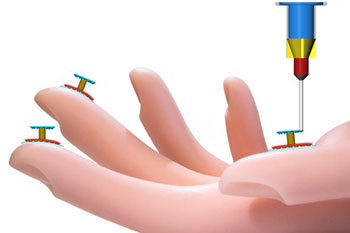3D printer creates flexible electronic sensors that provide a sense of touch
Breakthrough paves way for tactile devices to be printed directly onto human skin
NIBIB-funded researchers have developed a revolutionary 3D printer that paves the way for direct printing of biomedical devices onto human skin. The printer builds flexible electronic sensors that measure pressure. They’re expected to improve sensation in prosthetic hands and surgical robotic arms.
“Imagine putting your arm under a printer and printing a device or sensor. You don’t need a microfabrication center, you don’t need a doctor. This is the future of 3D printing and electronics,” says lead study author Michael McAlpine, Ph.D., a 2017 recipient of the Presidential Early Career Award for Scientists and Engineers (PECASE) and the Benjamin Mayhugh Associate Professor of Mechanical Engineering at the University of Minnesota.

An illustration of a flexible sensor that can detect movement being printed onto a human hand model. Credit: Michael McAlpine, University of Minnesota.
McAlpine’s team at the University of Minnesota’s College of Science and Engineering built the multifunctional 3D printer over the course of several months. It uses novel inks that cure at room temperature, which is different from conventional 3D printers that require hot ink and produce a hard plastic product.
“Our printers can expand the potential of what 3D printing is capable of,” says McAlpine. The newly-developed printer “is much different than what is currently available,” he notes. “Using functional ink that cures under mild conditions opens up avenues to printing on all sorts of surfaces, including human skin or inside the body.”
The inks are made of tiny silver particles mixed into a flexible silicone material that can stretch to three times its original size. A sensor is printed in six consecutive layers: a silicone interface layer, a bottom electrode layer, a coil-shaped sensor layer, an isolating layer, a supporting layer, and a top electrode layer. The supporting layer is washed away in the final manufacturing process.
The researchers tested the sensor in two ways for its mechanical properties. First, it was printed onto a fingertip on a model of a human hand, and second, a newly printed sensor was placed above the radial artery at the wrist to monitor the physical force of a pulse in real time. Results showed that the sensor could detect small forces from the wrist pulse, and could discriminate between a sedentary user and an active one.In the first case, the researchers performed a 3D scan of a human hand model in order to map the curved surface of the fingertip. They then used the data to conformally print a sensor directly onto the model’s fingertip. Feedback from pressing the finger was measured, setting the stage for future applications in direct printing of devices onto the body.
"The bioprinting technique developed by Dr. McAlpine carries the promise of giving individuals with artificial limbs better control,” said Šeila Selimović, Ph.D., director of the NIBIB programs in Biosensors, Tissue Chips and Tissue Preservation Technologies. “I expect to see it used in real life situations where a person has lost function of a hand or arm. Because it could offer a high level of tactile sensitivity, when coupled with a prosthetic it could allow, for instance, a person to hold an egg without crushing it.”
McAlpine said he expects to see clinical applications in the near future where a sensitive grip is important, such as in robotic-assisted surgery. “Currently, doctors have to look at a monitor to avoid scraping the organ surface while using the two (robotic) grabber arms. They use their eyes as a guide. If they can have touch feedback, they could have better precision with fewer surgical errors.”
The research, he says, could lead to the development of complex devices such as heat and light sensorsthat can detect cancer and monitor cells for wound healing.
Future research on tactile sensors will focus on several areas: developing a process in which a real-time scan of a hand is immediately followed by the printing of a sensor; creating sensors to monitor tissue; and further optimizing the inks. “We’re looking at new inks right now that mimic the way the body translates signals,” notes McAlpine.
He predicts that 3D printers that print custom biomedical devices directly onto human skin could be widely deployed in five to 10 years, and may even be available for home-based use within that timeframe.
This work was supported by the National Institute of Biomedical Imaging and Bioengineering grant # EB020537.
—Lisa Smith, special to NIBIB
Program Area:
Health Terms:
Medical Devices,
Modeling and Simulation























.png)











No hay comentarios:
Publicar un comentario